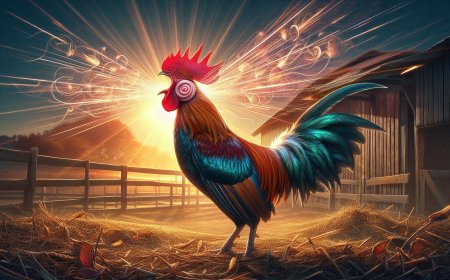Rooster’s Soundproof Secret: How They Protect Themselves from Deafening Crows
Discover the amazing secret of how roosters protect themselves from their own deafening crows. Learn about the natural soundproofing mechanism that helps these birds prevent hearing damage while crowing loudly.

Roosters are famous for their loud, piercing crowing that signals the start of a new day. But with an average crow reaching over 100 decibels—akin to the roar of a chainsaw—how do these birds avoid going deaf from their own noise? Researchers from the University of Antwerp and the University of Ghent recently solved this mystery, uncovering the fascinating adaptations that protect roosters from self-induced hearing loss.
A Crow That Rivals a Chainsaw
To understand the sheer power of a rooster’s crow, the research team placed tiny microphones near the ears of several roosters. What they found was remarkable: a rooster’s crow is not just a wake-up call; it’s a thunderous blast. At over 100 decibels, this noise level is more than enough to cause hearing damage in humans after prolonged exposure.
Humans, like most animals, are susceptible to noise-induced hearing loss, where the tiny hair cells in the inner ear become irreparably damaged. Roosters, too, possess these delicate hair cells. So, why don’t they go deaf?
The Rooster’s Built-In Earplugs
The answer lies in the rooster’s unique anatomy. Through detailed scans of the birds’ skulls, the researchers uncovered two ingenious adaptations that help these feathered alarm clocks protect their hearing.
First, they found that soft tissue covers a portion of the rooster’s eardrum, naturally dampening sound even before it reaches the inner ear. But even more impressive is what happens when a rooster gets ready to crow. As the bird throws its head back to let out that famous call, another piece of material within its ear acts like a built-in earplug, sealing the ear canal completely. This clever mechanism works much like humans plugging their ears to muffle loud sounds, offering the rooster protection against its own noise.
A Regenerative Superpower
There’s another secret weapon in a rooster’s hearing defense: unlike humans, birds have the remarkable ability to regenerate damaged hair cells in their ears. This biological superpower provides an extra safeguard, ensuring that any minor damage caused by their crowing can be repaired naturally over time.
Crow Protection for the Flock
While roosters have their own built-in defenses, what about the hens and chicks that have to live with the constant crowing? Although not directly covered in the study, there’s an interesting behavioral adaptation at play. Roosters often perch on elevated, distant spots when they crow, broadcasting their call far and wide while keeping a safe distance from the rest of the flock. This helps reduce the impact of their booming crow on nearby hens and chicks, keeping them out of earshot of the worst of the noise.
Nature’s Ingenious Design
The rooster’s soundproofing system is a testament to the wonders of evolution. With a combination of anatomical adaptations and behavioral strategies, these birds are able to belt out their daily calls without fear of going deaf. The natural world is full of such clever solutions, and this discovery adds yet another layer to the fascinating complexity of animal biology.
So the next time you hear a rooster crow, know that beneath its raucous call lies an incredible, built-in defense—nature’s perfect solution to an otherwise deafening dilemma.
What's Your Reaction?






































































































